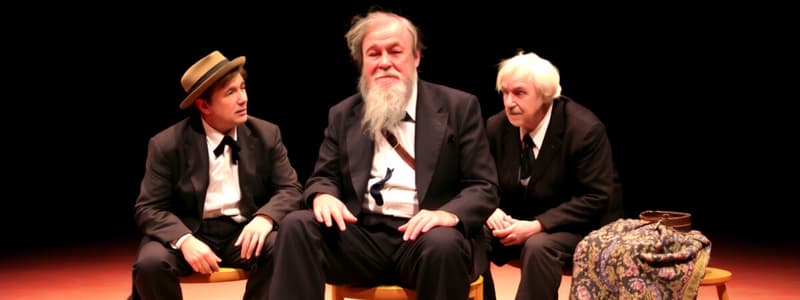Podcast
Questions and Answers
What work is recognized as the predecessor of the Theatre of the Absurd?
What work is recognized as the predecessor of the Theatre of the Absurd?
- The Metamorphosis by Franz Kafka
- Waiting for Godot by Samuel Beckett
- Ubu Roi by Alfred Jarry (correct)
- A Midsummer Night's Dream by William Shakespeare
Which artistic movement heavily influenced the Theatre of the Absurd, particularly through its emphasis on the subconscious?
Which artistic movement heavily influenced the Theatre of the Absurd, particularly through its emphasis on the subconscious?
- Cubism
- Surrealism (correct)
- Dadaism
- Impressionism
What catastrophic event is cited as a catalyst for the emergence of the Theatre of the Absurd?
What catastrophic event is cited as a catalyst for the emergence of the Theatre of the Absurd?
- The Great Depression
- World War I
- The Cold War
- World War II (correct)
Which playwright is recognized for rejecting realism and advocating for a return to myth in the theatre?
Which playwright is recognized for rejecting realism and advocating for a return to myth in the theatre?
Which of the following elements contributed to the development of the Theatre of the Absurd?
Which of the following elements contributed to the development of the Theatre of the Absurd?
What does Albert Camus argue about the human condition in his essay, The Myth of Sisyphus?
What does Albert Camus argue about the human condition in his essay, The Myth of Sisyphus?
Which playwright is NOT commonly associated with the Theatre of the Absurd?
Which playwright is NOT commonly associated with the Theatre of the Absurd?
What does the term ‘Theatre of the Absurd’ aim to highlight according to Martin Esslin?
What does the term ‘Theatre of the Absurd’ aim to highlight according to Martin Esslin?
Which of the following is a precursor to the Theatre of the Absurd?
Which of the following is a precursor to the Theatre of the Absurd?
Which of the following playwrights referred to their works as 'Anti-Theater' or 'New Theater' rather than Theatre of the Absurd?
Which of the following playwrights referred to their works as 'Anti-Theater' or 'New Theater' rather than Theatre of the Absurd?
Flashcards are hidden until you start studying
Study Notes
Theatre of the Absurd
- Coined by Martin Esslin in his 1962 book
- Refers to a type of play popular in 1950s and 1960s
- Plays reflect Albert Camus' philosophy of the "absurd" human condition, described in his 1942 essay, "The Myth of Sisyphus"
- Emphasizes the meaninglessness of the universe and humanity's inability to find rational explanations
- Esslin uses the term "device" to highlight key characteristics in the works of various playwrights
- Playwrights convey bewilderment, anxiety, and wonder in the face of an inexplicable universe
Key Playwrights
- Five defining writers: Eugène Ionesco, Samuel Beckett, Jean Genet, Arthur Adamov, and Harold Pinter
- Playwrights often preferred terms like "Anti-Theater" or "New Theater"
- Other associated playwrights include Tom Stoppard, Arthur Kopit, Friedrich Dürrenmatt, Fernando Arrabal, Edward Albee, N.F.Simpson, Boris Vian, Peter Weiss, Vaclav Havel, and Jean Tardieu
Influences and Precursors
- Rooted in avant-garde experiments of the 1920s and 1930s
- Absurd elements emerged in ancient Greek drama, particularly in the wild humor of Old Comedy and the plays of Aristophanes
- Developed in the late classical period by Lucian, Petronius, and Apuleius in Menippean satire
- Precursors include the morality plays of the Middle Ages and the Baroque allegorical drama of Elizabethan times
- Influenced by Alfred Jarry's "Ubu Roi" (1896), a monstrous puppet-play depicting the animalistic nature of humanity
- Surrealist movement of the 1920s and 1930s influenced by Freud's theories on the subconscious mind
- Inspired by dream novels of James Joyce and Franz Kafka, exploring the universal significance of their private obsessions
- Inspired by silent film, comedy, and verbal nonsense traditions of Laurel and Hardy, W.C. Fields, and the Marx Brothers
- Influenced by the verbal nonsense of François Rabelais, Lewis Carroll, Edward Lear, and Christian Morgenstern
World War II and The Birth of the Movement
- World War II served as a catalyst for the rise of the Theatre of the Absurd
- The global nature of the conflict and the threat of nuclear annihilation highlighted the precariousness of human life
- Antonin Artaud (1896-1948) emerged as a proponent of the absurd, rejecting realism in theatre and advocating for a return to myth, magic, and the exposure of the deepest human conflicts
- Artaud called for a theatre that would create collective archetypes and a modern mythology
Studying That Suits You
Use AI to generate personalized quizzes and flashcards to suit your learning preferences.




